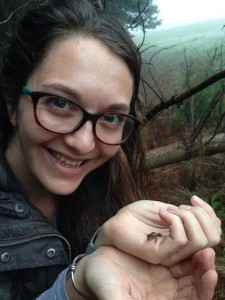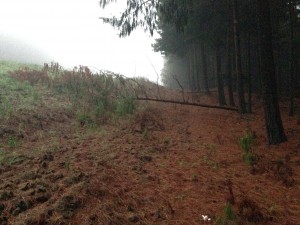
It’s a little bit daunting to study a species you have never actually encountered before. When I was compiling my EDGE Fellowship application and project proposal for the Mistbelt Chirping Frog, having to find the species was something of a “future problem”. Of course, it is possible to study a species and never ever get to see it alive, and many biologists face that difficult task. But there is something special about actually meeting the animal you’re trying to save. And it is that something that I hoped to find when the time came for my field work.
So, in December 2015 I set out with a team of experienced froggers, all involved in amphibian conservation research. But nobody had actually seen the species before. All we had to go on were some GPS coordinates from audio detections 8 years ago, and a digital recording of the frog’s call, which to the untrained ear sounds like any chirping insect.
We had only four nights in which to survey five sites. And those who have studied elusive amphibians will know that weather is a major factor in whether you detect your calling frog species or not. But our trip was planned months in advance and there was little room to move. Flights were booked, the weather just had to play ball.
We set out on our first survey on a very hot afternoon, worried by the intense lack of rainfall the area had experience in the previous months. But luck was on our side. An electric storm pulled in and we literally had to run for cover and hide in the car for 45 minutes, waiting for the intense lightning to pass. As the storm subsided, we decided it was time to demarcate the area for our Song Meter array set-up, and there it was. The sweetest chirp I ever did hear. We quickly set up our Song Meters and gathered the first ever spatially explicit capture-recapture data for the species. And Lady Luck didn’t desert us. We heard the frog at four of the five sites that we surveyed. But just because we heard the frog, didn’t mean we could see it. This tiny amphibian is only 20mm in length, and it is the exact colour of the thick grass understory that it occupies. So finding one, at night, was incredibly difficult.
But on our second last night, we struck gold. We were driving along the dirt roads among the pine plantations that fragment the habitat of our study subject. We heard a lone male calling from a road verge and decided to investigate. We followed the call to a thicket of pine needles and patchy grassland, under a fallen pine tree that was once part of the plantation.

We knew the frog was right there, within the square meter in front of us. Yet it took three experienced froggers almost 20 minutes’ of triangulation, on our knees, digging through pine needles and grass to finally see it. It was a beautiful moment. Needless to say we were all elated at this “lifer” (our name for a species we are seeing for the first time in our lives). And the size of this beautiful bronze little frog reminded me just how vulnerable this little guy is. But the locality also gave me hope, that this species has some resilience to it, and with a little bit of effort, improved management practices and a good helping of environmental education, we have a good chance to save the Mistbelt Chirping Frog.
